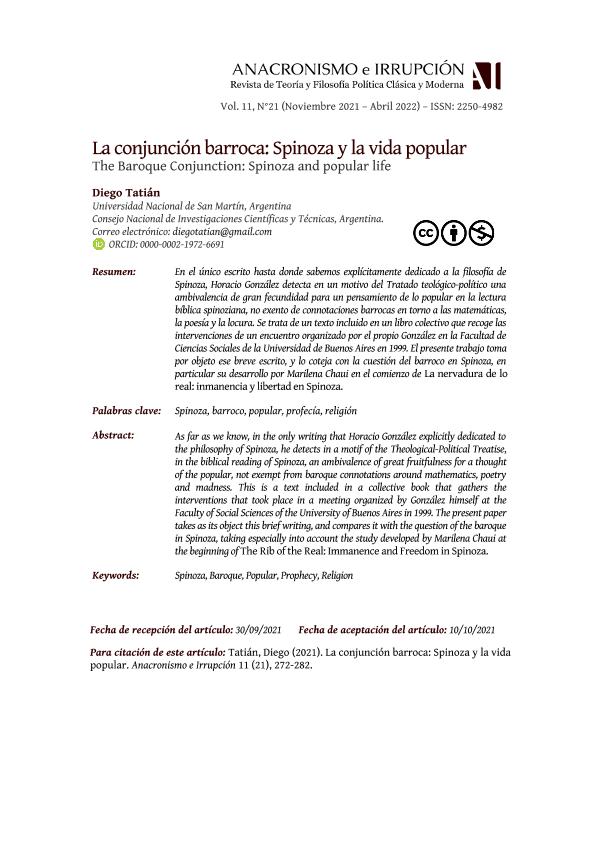Mostrar el registro sencillo del ítem
dc.contributor.author
Tatián, Diego

dc.date.available
2022-10-14T12:40:18Z
dc.date.issued
2021-11
dc.identifier.citation
Tatián, Diego; La conjunción barroca: Spinoza y la vida popular; Universidad de Buenos Aires. Facultad de Ciencias Sociales. Instituto de Investigaciones Gino Germani; Anacronismo e Irrupción; 11; 21; 11-2021; 271-282
dc.identifier.issn
2250-4982
dc.identifier.uri
http://hdl.handle.net/11336/173177
dc.description.abstract
En el único escrito hasta donde sabemos explícitamente dedicado a la filosofía de Spinoza, Horacio González detecta en un motivo del Tratado teológico-político una ambivalencia de gran fecundidad para un pensamiento de lo popular en la lectura bíblica spinoziana, no exento de connotaciones barrocas en torno a las matemáticas, la poesía y la locura. Se trata de un texto incluido en un libro colectivo que recoge las intervenciones de un encuentro organizado por el propio González en la Facultad de Ciencias Sociales de la Universidad de Buenos Aires en 1999. El presente trabajo toma por objeto ese breve escrito, y lo coteja con la cuestión del barroco en Spinoza, en particular su desarrollo por Marilena Chaui en el comienzo de "La nervadura de lo real: inmanencia y libertad en Spinoza".
dc.description.abstract
As far as we know, in the only writing that Horacio González explicitly dedicated to the philosophy of Spinoza, he detects in a motif of the Theological-Political Treatise, in the biblical reading of Spinoza, an ambivalence of great fruitfulness for a thought of the popular, not exempt from baroque connotations around mathematics, poetry and madness. This is a text included in a collective book that gathers the interventions that took place in a meeting organized by González himself at the Faculty of Social Sciences of the University of Buenos Aires in 1999. The present paper takes as its object this brief writing, and compares it with the question of the baroque in Spinoza, taking especially into account the study developed by Marilena Chaui at the beginning of The Rib of the Real: Immanence and Freedom in Spinoza.
dc.format
application/pdf
dc.language.iso
spa
dc.publisher
Universidad de Buenos Aires. Facultad de Ciencias Sociales. Instituto de Investigaciones Gino Germani

dc.rights
info:eu-repo/semantics/openAccess
dc.rights.uri
https://creativecommons.org/licenses/by-nc-sa/2.5/ar/
dc.subject
SPINOZA
dc.subject
BARROCO
dc.subject
PUEBLO
dc.subject
ARTE
dc.subject.classification
Filosofía, Historia y Filosofía de la Ciencia y la Tecnología

dc.subject.classification
Filosofía, Ética y Religión

dc.subject.classification
HUMANIDADES

dc.title
La conjunción barroca: Spinoza y la vida popular
dc.title
The Baroque Conjunction: Spinoza and popular life
dc.type
info:eu-repo/semantics/article
dc.type
info:ar-repo/semantics/artículo
dc.type
info:eu-repo/semantics/publishedVersion
dc.date.updated
2022-09-21T10:35:52Z
dc.journal.volume
11
dc.journal.number
21
dc.journal.pagination
271-282
dc.journal.pais
Argentina

dc.journal.ciudad
Buenos Aires
dc.description.fil
Fil: Tatián, Diego. Universidad Nacional de San Martín. Escuela de Humanidades; Argentina. Universidad Nacional de San Martín. Escuela de Humanidades. Laboratorio de Investigación en Ciencias Humanas - Consejo Nacional de Investigaciones Científicas y Técnicas. Oficina de Coordinación Administrativa Parque Centenario. Laboratorio de Investigación en Ciencias Humanas; Argentina
dc.journal.title
Anacronismo e Irrupción
dc.relation.alternativeid
info:eu-repo/semantics/altIdentifier/url/https://publicaciones.sociales.uba.ar/index.php/anacronismo/article/view/7088/5921
Archivos asociados
